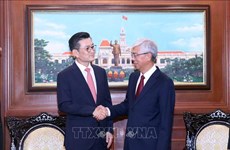Vietnam, China enforce major border accords
Vietnam and China have enforced a Protocol on Border
Demarcation and Marker Planting, an Agreement on Border Management
Regulations and an Agreement on Border Gates and Border Gate Management
Regulations, which were signed on November 18, 2009.
Vietnam and China have enforced a Protocol on Border
Demarcation and Marker Planting, an Agreement on Border Management
Regulations and an Agreement on Border Gates and Border Gate Management
Regulations, which were signed on November 18, 2009.
A governmental-level ceremony to announce the enforcement of the three accords was held at the Thanh Thuy-Tian Bao border gate between the Vietnamese northern mountainous province of Ha Giang and the Chinese southern province of Yunnan on July 14.
The ceremony was co-chaired by Deputy Foreign Minister Ho Xuan Son, Head of the Vietnamese Government Delegation on Border and Territory Negotiations, and his Chinese counterpart Zhang Zhijun.
Representatives from relevant ministries, agencies, and border provinces of the two countries, the Vietnamese Consul General in Nanning and Kunming cities of China , the Chinese Ambassador to Vietnam , and a large number of residents along the shared border attended the event.
Both Son and Zhang applauded the significance of the enforcement of the accords, officially ending 36 years of negotiations on land boundary issues between the two nations.
The event marked another milestone in bilateral relations and created a foundation for the building of a common borderline of peace, friendship and long-term stability, thereby helping to elevate the Vietnam-China comprehensive strategic cooperative partnership to a new height, they said.
The deputy ministers proposed relevant ministries, agencies and localities of both countries to continue working together to effectively enforce the accords.
In an interview granted to the Vietnam News Agency (VNA) following the event, Son said the three freshly-enforced accords along with the Vietnam-China treaty on land borders signed in 1999 made up the most complete code of dossiers on the Vietnam-China land borderline.
These documents will replace the French-Qing conventions signed in 1887 and 1895, as well as the provisional agreement on addressing border affairs signed between the governments of Vietnam and China in 1991.
According to Son, who is also Head of the National Border Committee, there are many differences between the new documents and the previous ones.
In the new documents, border sections and markers between the two nations are demonstrated clearly, not only by words but also by sketches and maps, which help people find it easy to recognise the borderline. These documents also clearly set out specific activities undertaken by the concerned agencies in managing and protecting the borderline and markers.
The new Agreement on Border Management Regulations gives more detailed regulations on the management, protection, exploitation and use of water from border rivers and streams, and the cross-border travel of people, vehicles and commodities. It clearly states the coordination mechanism in maintaining and ensuring security and order in border areas.
The agreement is accompanied by 18 appendices which regulate the paper forms for exchange between the two sides when dealing with affairs in areas along the shared border.
The new Agreement on Border Management Regulations also outlines principles and specific measures to be taken in addressing issues related to the Vietnam-China land border, including issues such as measures to tackle illegal immigration, principles on the construction of projects in border water and border areas, and the repair and restoration of border markers.
One outcome of the Agreement on Border Management Regulations is the establishment of the Vietnam-China Joint Committee on Land Border to coordinate, speed up and supervise border management. Under the terms of the agreement, the common borderline is divided into eight sections and each country will assign eight national representatives to undertake the management of these sections.
The Vietnam-China land border measures 1,449.56 kilometres, of which 383.91 kilometres run along rivers and streams. The two sides have already built 1,971 markers, including a marker at the Vietnam-China-Laos border T-junction, 1,548 major markers and 422 auxiliary markers.
These markers and documents lay a firm legal foundation for the two nations to build a common borderline of peace, friendship, stability and long-term development.
Following the ceremony, the two sides held talks in Ha Giang province to discuss measures to implement the three accords. Accordingly, the two sides agreed to set up the Vietnam-China Joint Committee on Land Border, appoint national border representatives and establish a liaison mechanism to deploy the Agreement on Border Gates and Border Gate Management Regulations./.
A governmental-level ceremony to announce the enforcement of the three accords was held at the Thanh Thuy-Tian Bao border gate between the Vietnamese northern mountainous province of Ha Giang and the Chinese southern province of Yunnan on July 14.
The ceremony was co-chaired by Deputy Foreign Minister Ho Xuan Son, Head of the Vietnamese Government Delegation on Border and Territory Negotiations, and his Chinese counterpart Zhang Zhijun.
Representatives from relevant ministries, agencies, and border provinces of the two countries, the Vietnamese Consul General in Nanning and Kunming cities of China , the Chinese Ambassador to Vietnam , and a large number of residents along the shared border attended the event.
Both Son and Zhang applauded the significance of the enforcement of the accords, officially ending 36 years of negotiations on land boundary issues between the two nations.
The event marked another milestone in bilateral relations and created a foundation for the building of a common borderline of peace, friendship and long-term stability, thereby helping to elevate the Vietnam-China comprehensive strategic cooperative partnership to a new height, they said.
The deputy ministers proposed relevant ministries, agencies and localities of both countries to continue working together to effectively enforce the accords.
In an interview granted to the Vietnam News Agency (VNA) following the event, Son said the three freshly-enforced accords along with the Vietnam-China treaty on land borders signed in 1999 made up the most complete code of dossiers on the Vietnam-China land borderline.
These documents will replace the French-Qing conventions signed in 1887 and 1895, as well as the provisional agreement on addressing border affairs signed between the governments of Vietnam and China in 1991.
According to Son, who is also Head of the National Border Committee, there are many differences between the new documents and the previous ones.
In the new documents, border sections and markers between the two nations are demonstrated clearly, not only by words but also by sketches and maps, which help people find it easy to recognise the borderline. These documents also clearly set out specific activities undertaken by the concerned agencies in managing and protecting the borderline and markers.
The new Agreement on Border Management Regulations gives more detailed regulations on the management, protection, exploitation and use of water from border rivers and streams, and the cross-border travel of people, vehicles and commodities. It clearly states the coordination mechanism in maintaining and ensuring security and order in border areas.
The agreement is accompanied by 18 appendices which regulate the paper forms for exchange between the two sides when dealing with affairs in areas along the shared border.
The new Agreement on Border Management Regulations also outlines principles and specific measures to be taken in addressing issues related to the Vietnam-China land border, including issues such as measures to tackle illegal immigration, principles on the construction of projects in border water and border areas, and the repair and restoration of border markers.
One outcome of the Agreement on Border Management Regulations is the establishment of the Vietnam-China Joint Committee on Land Border to coordinate, speed up and supervise border management. Under the terms of the agreement, the common borderline is divided into eight sections and each country will assign eight national representatives to undertake the management of these sections.
The Vietnam-China land border measures 1,449.56 kilometres, of which 383.91 kilometres run along rivers and streams. The two sides have already built 1,971 markers, including a marker at the Vietnam-China-Laos border T-junction, 1,548 major markers and 422 auxiliary markers.
These markers and documents lay a firm legal foundation for the two nations to build a common borderline of peace, friendship, stability and long-term development.
Following the ceremony, the two sides held talks in Ha Giang province to discuss measures to implement the three accords. Accordingly, the two sides agreed to set up the Vietnam-China Joint Committee on Land Border, appoint national border representatives and establish a liaison mechanism to deploy the Agreement on Border Gates and Border Gate Management Regulations./.












